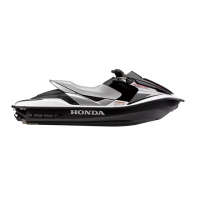
Do you have a question about the Honda AQUATRAX R-12X 2005 and is the answer not in the manual?
| Manufacturer | Honda |
|---|---|
| Model | AQUATRAX R-12X |
| Year | 2005 |
| Category | Boat |
| Type | Personal Watercraft |
| Displacement | 1235 cc |
| Cylinders | 4 |
| Fuel Capacity | 16.6 gallons |
| Height | 41.7 inches |
| Seating Capacity | 3 |
| Starter | Electric |
| Lubrication System | Wet Sump |
| Cooling System | Water-cooled |
| Engine Type | 4-stroke |
| Fuel System | PGM-FI (Programmed Fuel Injection) |
| Hull Material | Fiberglass Reinforced Plastic |
| Impeller Type | Axial flow single stage |
Explains hazard signal words (DANGER, WARNING, CAUTION) used in the manual.
Key safety recommendations and advice for riders.
Identifies and explains warning labels found on the PWC.
Identifies all parts and controls on the PWC's exterior and interior.
Details dashboard indicators, readouts, and their meanings.
Explains the ID lock system and limit mode features.
Describes steering, throttle, trim, and reverse levers/buttons.
Describes water intake, cooling outlet, and jet pump steering nozzle.
Describes drain plugs, flushing connector, eyelets, and grab rail.
Assesses operator and PWC readiness before riding.
Detailed pre-ride inspection checklist for the PWC.
Information on capacity limits for passengers and cargo.
Details storage locations and weight limits for cargo.
Essential safety guidelines to follow before and during operation.
Step-by-step guide for starting and stopping the PWC engine.
Procedures for getting the PWC into and out of the water.
Explains how to maneuver turns using controls.
Explains how to engage and use reverse thrust.
Procedures for bringing the PWC to a safe stop.
Guidelines for safely carrying passengers and load.
Steps to perform for PWC upkeep after riding.
Explains why regular maintenance is crucial for safety and performance.
Crucial safety precautions to observe during maintenance.
Specific safety warnings for maintenance tasks.
Recommended service intervals and specific maintenance tasks.
Log for recording service performed on the PWC.
Steps and tools needed before performing service tasks.
Fuel recommendations and refueling procedures.
Checking, adding, and changing engine oil and filter.
Maintenance procedures for the PWC's air filter.
Points and procedures for lubricating moving parts.
Inspection and adjustment of the throttle system.
Procedures for inspecting and replacing spark plugs.
Procedures for flushing the PWC's cooling system.
Information on battery maintenance, charging, and storage.
Cleaning and polishing procedures for the PWC's exterior.
Procedures for long-term storage of the PWC.
Guidelines for safe trailer transport of the PWC.
Tips for responsible PWC operation to protect nature.
General advice for handling common PWC problems on the water.
Troubleshooting steps for engine starting issues.
Steps to take if the PWC engine overheats.
What to do if the low oil pressure warning is active.
Troubleshooting electrical issues related to blown fuses.
Procedures to follow after a PWC collision.
Instructions on how to tow the PWC.
Steps to take if the PWC overturns.
Procedures to follow if the PWC goes underwater.
How to clear blockages in the intake or propulsion system.
Troubleshooting steps for battery issues.
Information on serial and identification numbers for the PWC.
Technical data including dimensions, weight, and capacities.
Instructions for the initial break-in period of the PWC.
Information on exhaust and emissions control systems.
Explanation of the PWC's emission rating labels.
Information regarding the use of oxygenated fuels.
Information on purchasing official Honda service and owner's manuals.
Details on the PWC's warranty terms and coverage.
How to obtain warranty repairs and service.
Contact information for Honda customer support.
Information about dealer services and support.
How to report safety defects to authorities.
Tips to prevent expensive repairs through proper maintenance.